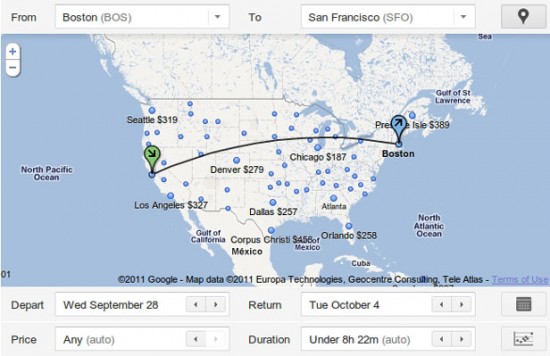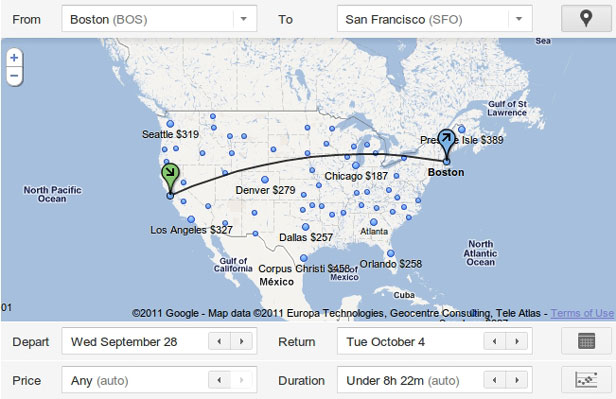Google Flight Search Suffers Some Turbulence
It may work with jetlike speed, but other services still offer greater choice.



In April this year, Google bought ITA Software, a company that provides airfare data to travel sites including Kayak, Hipmunk, and Orbitz. This month, after the U.S. Department of Justice gave permission for the acquisition of ITA under conditions designed to maintain healthy competition in the sector, Google launched its own travel service, called Flight Search.
Google users can now search for, say, “flight from Boston to San Francisco,” click on the “Flights” button that appears at the left of the Flight Search screen, and see options and prices in a fraction of a second—considerably faster than many other airfare services. A user can adjust parameters like date, time, and number of stops, and then select and purchase a ticket.
Flight Search also offers some nifty innovative features, such as a map that lets users click on cities to choose a route and a chart that shows how price fluctuates over time. The latter is especially helpful.
As Google often does, it emphasized how fast Flight Search is in a video introducing the new service, promising “results that update instantly”—that is, when a user changes a parameter like date or destination, the change in the results is immediate. Many other airfare search sites take several seconds to load new results.
But is faster really better? When comparing Flight Search with services like Kayak, Hipmunk, and even Expedia, a user will quickly notice that not only are some airlines missing from Flight Search, but entire airports—and every country except the U.S.—are missing as well.
Lance Cottrell, founder and chief technology officer of Anonymizer, a company that helps businesses perform anonymous research on competitors, says Google and ITA may be pre-calculating, or “caching,” flight information in order to return results fast. According to Cottrell, “The number of possible routes is large—but nothing like the amount of data that Google is used to handling.”
George Hobica, founder of Airfarewatchdog, a site that compiles airfare deals directly from the airlines and lists them, believes that part of the reason the service is so speedy is that it has a “smaller inventory to search through” than other sites.
Cottrell reports that the first airport he tried wasn’t in Google’s system at all. Google excuses this by saying, in a blog post, that this is “the takeoff, not the final destination,” of Flight Search. The company says it plans to add the missing airports and airlines in the near future, as well as international flights. Google representatives were unavailable for comment.
Jacqueline Tanzella, a spokesperson for Hipmunk, says that her company isn’t worried about competition from Google because Hipmunk provides more information and has a very loyal user base.
Travelers are likely to prefer choice over speed of search, but if Google can improve its inventory of airlines and cities quickly, then Flight Search could really take off.